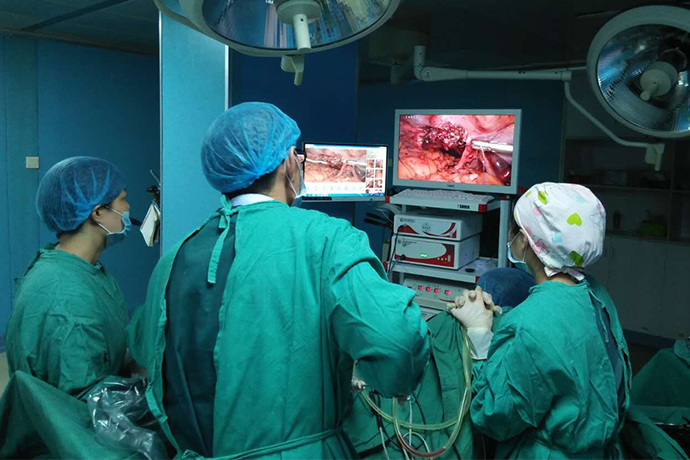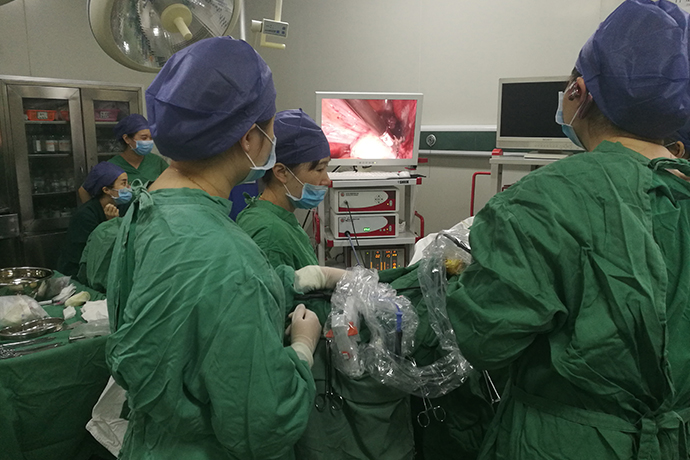[Gynecological Laparoscopy] 4K laparoscopic rudimentary horn hysterectomy
Release time: 24 Oct 2023 Author:Shrek
1. What is rudimentary uterus?
Rudimentary uterus is a congenital developmental malformation of the uterus. It is the result of an abnormality in the fusion process of the paramesonephric ducts during the embryonic period, resulting in underdevelopment of one side of the paramesonephric ducts. In addition to the normal uterus, there is also a smaller uterus, which is called rudimentary uterus. Most of the "residual horns" are not connected to the better-developed uterus on the other side, and are only connected through fibrous bands.

2. How can a rudimentary uterus become pregnant?
The sperm travels outside the fallopian tube of the normal uterus to the fallopian tube of the rudimentary uterus, combines with the egg, and enters the rudimentary horn.
The fertilized egg travels out of the fallopian tube of the normal uterus to the fallopian tube of the rudimentary uterus and implants in the rudimentary uterus.
3. Does rudimentary uterus need treatment?
Although the uterus with rudimentary horns has an endometrium, it is not functional, is not uncomfortable, and does not require treatment.
The uterus with rudimentary horns has an endometrium and will experience periodic bleeding. However, because it is blocked from the normal uterine cavity and the blood cannot be discharged, it will cause dysmenorrhea and even endometriosis, and the rudimentary horns need to be removed.
In rudimentary uterine pregnancy, because the myometrium of the uterus is not well developed, as the fetus continues to grow, complete or incomplete rupture of the myometrium will occur. The rupture will cause severe intra-abdominal bleeding and endanger the patient's life. Most ruptures occur between 14 and 20 weeks of pregnancy, and gestation rarely reaches full term. Therefore, once a rudimentary horn uterine pregnancy is diagnosed, surgery should be performed as soon as possible to remove the rudimentary horn. If the fetus survives, a cesarean section is performed to remove the fetus first, and then the rudimentary horn is removed.
Although rudimentary uterus is not common, Li's experience reminds all women of childbearing age.
Pre-pregnancy examination is very important to detect malformations of reproductive organ development in time.
Abdominal pain in the second trimester of pregnancy is not necessarily a sign of threatened abortion, and miscarriage should not be treated blindly.
Laparoscopic rudimentary horn hysterectomy is one of the common gynecological surgeries. The specific operation process is as follows: Laparoscopic rudimentary horn hysterectomy.
1. Perform epidural anesthesia or general anesthesia after routine disinfection.
2. The patient is placed in the bladder lithotomy position, followed by routine disinfection and drape.
3. Inflate from the lower abdomen, puncture the cannula and place the laparoscope.
4. Use laparoscopy to explore the pelvic cavity to understand the size, shape and position of the uterus and its relationship with surrounding organs.
5. Use forceps to lift the lateral round ligament of the residual horn of the uterus upward into the uterus, and cut off the round ligament with electrocoagulation.
6. Lift the fallopian tube on the uterine side of the residual horn and use bipolar electrocoagulation forceps to fully coagulate the ligament to close the blood vessels in the ligament and remove the fallopian tube on that side.
7. Wedge resection of the residual horn of the uterus, electrocoagulation to stop bleeding, suture the uterine wall with absorbable sutures, and suspend the round ligament from the uterine horn on that side.
8. Rinse the abdomen and pelvis, aspirate the accumulated fluid, remove the hysteroscope and cannula after expelling the gas, and suture the wound.
4. Case
Patients and measures: The patient is a 12-year-old girl with rudimentary uterus. There was no past history of disease. She started menarche at the age of 11, and then developed periodic left pelvic pain. Ultrasound examination revealed a uterus with double uterus and fluid retention on the left side. This type of uterine malformation is called an accessory uterine mass. Progesterone therapy was given. MRI examination showed left non-communicating rudimentary uterus with unicornuate uterus. No other malformations, including those of the kidneys, were found.
First, a vaginal endoscopy was performed and it was found that there was no abnormality in the vagina and only a cervix. Therefore, it was decided to undergo 4K ultra-high definition laparoscopic left rudimentary horn hysterectomy. Compared with the current standard medical and surgical procedures, minimally invasive surgery has less pain, better internal environment stability, more accurate surgical results, shorter hospitalization time and better psychological effects. It is becoming more and more popular. The more it is widely accepted by patients and their families.
1. After abdominal distension, insert a 10mm puncture hole in the umbilicus to place the lens, and make three other 5mm puncture holes. Abdominal evaluation revealed normal adnexa bilaterally, including the ovaries.
2. First use Ligasure to remove the left fallopian tube, close to the fallopian tube to preserve the blood supply to the ovary. Remove the remaining fimbriae to avoid cancer.
3. Open the bladder and uterine reflex, separate it from the cervix, and free the bladder from the residual horn of the uterus. A hole is made in the broad ligament and the left ureter is pushed laterally away. Ligasure is used to separate the left ovarian proper ligament and preserve the left ovary, which is supplied by the left pelvic infundibular ligament.
3. Free the left uterine artery, open the retroperitoneum, and use a monopolar electric hook to remove the left uterine horn. Slowly separate and selectively electrocoagulate until it reaches the uterine cavity of the rudimentary uterus, and old blood can be seen flowing out. Remove the entire uterine cavity and confirm that it is not connected to other uterine cavities.
4. Use 2-0 barbed suture to perform inversion suture to reconstruct the uterus, and finally place anti-adhesion preparation.
Conclusion: Laparoscopic treatment of rudimentary uterus is feasible and can achieve satisfactory uterine reconstruction results. This case is not the first report of laparoscopic surgery to treat rudimentary uterus. A similar case was reported in 2015, and another video recently described two similar cases.
First use a vaginal endoscope, that is, use a hysteroscope to observe the cervical condition in the vagina, so as to ensure a clear understanding of the cervical condition. This is a useful step for lesions such as reproductive tract malformations.
After hysterectomy, you need to pay attention to following the doctor's instructions, avoiding labor, strengthening nutrition, and regular review. The specific matters are as follows:
1. Pay attention to rest and avoid physical labor, especially heavy physical labor, to prevent wounds from cracking. You can return to the hospital for follow-up consultation one month after the operation, mainly to check the healing status of abdominal wounds and vaginal wounds.
2. Within 2 months after surgery, avoid squatting, lifting heavy objects and other movements to prevent increased abdominal pressure and vaginal incision bleeding.
3. Do not exercise strenuously and have sex within 3 months to prevent damage to the pelvic floor ligaments.
4. Strengthen nutrition, eat more vegetables and fruits to prevent constipation; eat more high-protein foods to enhance the body's immunity and promote wound healing; at the same time, avoid spicy, greasy foods.
5. Regularly review color ultrasound and hormone indicators after discharge.

- Recommended news
- 【General Surgery Laparoscopy】Cholecystectomy
- Surgery Steps of Hysteroscopy for Intrauterine Adhesion
- [Gynecological Hysteroscopy] Techniques for Preventing and Treating Complications of Hysteroscopic Surgery
- [Gynecological Hysteroscopy] Hysteroscopic Adhesiolysis
- [Gynecological Hysteroscopy] IUD Removal under Hysteroscopy